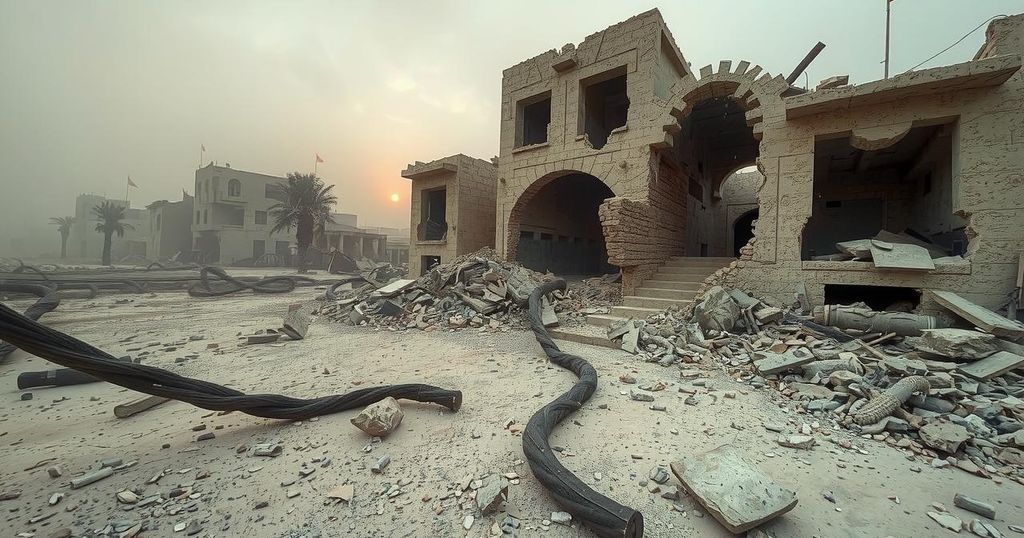The U.S. military has conducted air strikes on Houthi rebels in Yemen to protect navigation in the Red Sea and signal warnings to Iran. The strikes resulted in numerous casualties and highlighted the ongoing disruption of global shipping. Meanwhile, diplomatic tensions and regional conflicts are escalating, with Iran responding defiantly and domestic policies in the U.S. facing scrutiny.
The United States military commenced air strikes on Yemen’s Houthi rebels over the past weekend. President Donald Trump and Defense Secretary Pete Hegseth stated that these strikes aimed to safeguard “freedom of navigation” in the Red Sea while sending a warning to Iran. The action was prompted by an announcement from the Houthis regarding plans to attack Israeli ships, related to Israel’s halt of aid to Gaza. Reports indicate that the strikes resulted in 53 casualties, including five children and two women, while U.S. National Security Advisor Michael Waltz noted that several Houthi commanders were eliminated.
The ongoing Houthi military operations against commercial vessels have significantly disrupted global shipping during the Israel-Hamas war, with over 100 attacks reported since November 2023. Following the onset of a cease-fire between Israel and Hamas in January, Houthi assaults on shipping largely ceased. However, tensions escalated following Israel’s decision to cut food aid to Gaza on March 2, prompting the Houthis to threaten future attacks on Israeli vessels. Nonetheless, there have been no new reported threats over the weekend, despite the Houthis claiming they shot down a U.S. drone last week.
These air strikes mark the most significant military engagement for the Trump administration. In response, President Trump warned Iran that its support for the Houthis must cease “immediately,” while Iran’s foreign minister retorted that Washington lacks the authority to dictate Iranian policy. Although Trump has expressed intentions to negotiate a nuclear deal with Iran, Iranian officials have conveyed their refusal to engage under duress.
The U.S. strikes occurred amidst uncertainties surrounding the Gaza cease-fire, which is being debated for potential extension. Concurrently, Israel has continued air strikes in Gaza, causing additional casualties. Defense Secretary Hegseth emphasized that the U.S. would persist in its military actions against the Houthis until their attacks ceased.
Commenting on the situation, CFR expert Steven A. Cook remarked, “This is consistent with Washington’s global interest in freedom of navigation and serves as a warning to Iran… It seems that he and his advisors have determined that a military operation to ensure the safety of shipping in the Red Sea is worth the risk of open-ended conflict in the Middle East.”
In other news, an astronaut rotation took place at the International Space Station with a SpaceX capsule delivering four new astronauts. In Serbia, massive protests occurred against President Aleksandar Vučić’s government, reflecting widespread discontent. In Ukraine, Russian forces have progressed in the Kursk region, which Ukraine previously captured. Additionally, over a thousand journalists faced administrative leave due to funding cuts to U.S.-funded media, raising concerns regarding press freedom. The Trump administration’s deportations of alleged gang members have faced legal challenges, and tensions are resurfacing in Ethiopia’s Tigray region amid fears of civil conflict. Furthermore, China announced measures to boost domestic consumption, while India and New Zealand have resumed trade agreement negotiations.
In summary, the U.S. military’s air strikes on Yemen’s Houthi rebels signal a significant escalation in response to threats against commercial navigation in the Red Sea. This operation underscores ongoing tensions amid the Israel-Hamas conflict and highlights the broader implications for U.S.-Iran relations. Additionally, global protests, diplomatic negotiations, and domestic policy changes reflect a complex and evolving geopolitical landscape. Continued monitoring of the situation is imperative as these events unfold, particularly regarding their impact on regional and global stability.
Original Source: www.cfr.org




